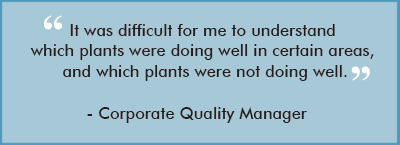Disparate Systems Impact Manufacturing Quality Due to Lack of Visibility Across Silos and a Reliance on Manual Approaches
The Cringe Factor
A corporate quality manager has responsibility for ten plants in North America. Whenever he received a complaint from a customer he would cringe – he felt like he was personally letting his customer and his company down. And he felt powerless to change the situation.
 Each facility had their own way of tracking defect data, and as the company acquired new plants the problem got worse. At the end of the month, the corporate quality manager received ten reports of the plants’ issues and resolutions, each in its own format. Every month he spent hours and hours compiling data and looking for patterns. It was next to impossible to figure out the root cause of the problem, let alone try to resolve it. “It was difficult for me to understand which plants were doing well… and which plants were not doing well.”
Each facility had their own way of tracking defect data, and as the company acquired new plants the problem got worse. At the end of the month, the corporate quality manager received ten reports of the plants’ issues and resolutions, each in its own format. Every month he spent hours and hours compiling data and looking for patterns. It was next to impossible to figure out the root cause of the problem, let alone try to resolve it. “It was difficult for me to understand which plants were doing well… and which plants were not doing well.”
Direct Impact on Quality
Disparate systems caused confusion. Customer complaints continued to mount. The corporate quality manager “could not guarantee customers were getting quality products.” The company needed to find a way to improve their quality across the board.
Actionable Data Creates Opportunity for Continuous Improvement
The corporate quality manager entrusted Hertzler Systems to provide an integrated platform that combines quality and defect information across multiple plants.
The resulting solution provided three advantages:
• Standardized data collection
• Increased timeliness of analytics
• Increased visibility at all levels
The Corporate Quality Manager Could Focus on the Analytics
As the company began to use GainSeeker they found that:
• The plants all collected data in the same system
• Defects were accurately captured and logged into a centralized database
• The platform provided confidence that the data was accurate
In addition, the standard platform could be adapted to various value streams, collecting defect information with defects appropriate for that product.
Shift From Reactive to Proactive Quality Management
It was no longer necessary to wait for the reports to come from the plant. He was empowered to access standardized, integrated quality information in real-time, getting a better sense of what is happening now instead of last month. This enabled the plants to react more quickly, minimizing risks and increasing their autonomy.
Unparalleled Visibility and Autonomy
This data visibility increased at every level. Operators could check on their current production. Plant managers could see how their individual plant was doing that day. And corporate quality managers could get a bigger picture across value streams. And from that high level, they could drill down to the operator level within a few clicks. “Our executives could not believe you could drill all the way down to the employee who found the defect in a matter of seconds.”
Confidence of Improved Quality Through Continual Improvement and Visibility
With full visibility into trusted information across plants, it is now possible to put continuous improvement methods in place that optimize the entire supply chain, increasing supply chain flexibility. The corporate quality manager can take pride in the improvement of quality, in the analytics, as well as in the associated decrease in client reported defects.
Open a pdf of this case study in a new window


